Loader Showdown
 A tumbleweed rolls by as the sun breaks. The eyes of the operators in the opposing loaders are locked in a dead stare as their hands command the controls. On this jobsite, there’s only room for one loader. Every good machine owner knows there is no lack of options when it comes to purchasing the best machine. It’s the duel of the compact loaders — a showdown that often centers on a smaller and more versatile skid steer loader and a larger, more productive compact wheel loader. Which one is right for you?
A tumbleweed rolls by as the sun breaks. The eyes of the operators in the opposing loaders are locked in a dead stare as their hands command the controls. On this jobsite, there’s only room for one loader. Every good machine owner knows there is no lack of options when it comes to purchasing the best machine. It’s the duel of the compact loaders — a showdown that often centers on a smaller and more versatile skid steer loader and a larger, more productive compact wheel loader. Which one is right for you?
“It’s not by gut feel. I can tell you that,” emphasizes shop manager Troy Bell, who oversees some 200 machines — including 18 skid steers — for ELS Construction in Phoenix. “Thinking you know intuitively can come back and bite you.”
Bell looks at ELS’s specific needs when recommending a machine for the company’s three main divisions (nursery, construction and maintenance).
“I’ll look at what we need in terms of lifting capacity, lift height, turn radius, payload and terrain,” says Bell. “When you look at all those factors, one of the two machines will come to the top.”
Not so long ago, the decision wasn’t that much of a dilemma. Skid steers, often the first purchase for small contractors and landscapers, were relegated to smaller jobs. As the company grew, a wheel loader would be the logical step up. Not so much anymore, according to Todd Lynnes, product marketing manager for Caterpillar. He notes that many users are making a larger skid steer loader that next choice. “The most popular size of skid steer remains those in the middle size class, those with a rated operating capacity (ROC) between 1,751 and 2,200 lbs,” says Lynnes. “There is, however, a definite movement upward. The small size has been growing into the middle size class and folks in the middle are moving up. Essentially, the small size market is shrinking and the top side, where there’s more concern about production, is growing fast.”
At that lower-size end, customers still put an emphasis on such things as price, size, weight and utility. At the higher, production-oriented end of the spectrum, customers look for lift height to load trucks and higher rated operating capacity to carry bigger loads and use heavier work tools.
“The ever increasing availability of new work tools and applications are a driving development of such things as high-flow hydraulics and machine and work tool control systems,” says Lynnes.
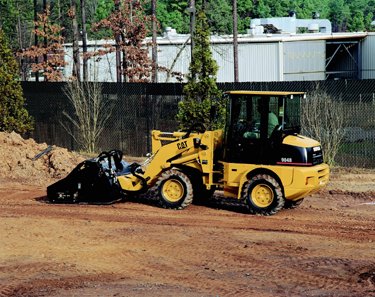
“There have been significant improvements in operator comfort,” says Lynnes. “As skid steers are used more for production, operators are spending more time in the cabs and they require and demand a cab in line with other construction equipment.”
Of course, the term “other construction equipment” includes the compact wheel loader. Cabs have been more reflective of their larger machine cousins — no small consideration when the work requires frequent in-and-out trips from the cab.
One differentiation of the compact wheel loader from larger wheel loaders is its use as a tool carrier — a task most still give an advantage to the skid steers because of their rigid frame design, visibility to the tool and high-flow hydraulic systems. Not unlike many operations with both types of machines, ELS has a stable of work tools for its skid steers and wheel loaders. Augers, trenchers and buckets are used on both machines, but the company also puts hammers and blades on its skid steers.
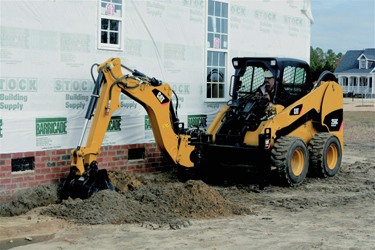
“We don’t use skid steers in the nursery,” says Don Harrison, ELS assistant nursery manager. “The wheel loader can handle a 48-in. tree box, which can weigh up to 4,000 lbs.
It also allows us to load a trailer from just one side. We bought it to move trees and it’s perfect for getting down the rows.”
Like ELS, Grieder Sod and Landscaping owns both types of machines. And like ELS, the Bloomington, Ill., company uses forks more than any other attachment on its compact wheel loader. Owner Denny Grieder sees the machines as two completely different animals.
“We may take the wheel loader out on larger jobs, but for the most part, its main use is in the yard,” he says. “It has a larger capacity and it’s ideal for moving pallets around an established site like our retail yard. We also use a bucket on it, along with hydraulic jaws for moving trees.”
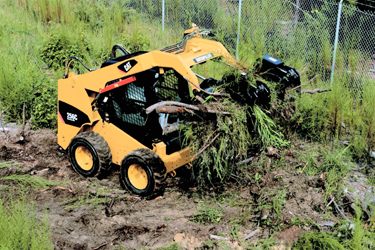
“Since it uses friction to turn, it tears the ground up compared to a wheel loader, which rolls over the ground,” says Bell. “That’s always a key consideration when deciding which machine to use.”
Visibility is another consideration. Although better visibility is a growing element in skid steer design, a wheel loader operator has a much better view of his surroundings. Still, when it comes to a close-up view of the cutting edge or work tool, no machine can match a skid steer loader.
Darren Wilson, who oversees compact wheel loader marketing for Caterpillar in North America, notes that while the market for compact wheel loaders has grown immensely in the last five or six years, it is not all at the expense of skid steers.
“Users are finding new applications. While it’s always been a good general purpose machine on a jobsite, the industrial waste and recycling businesses have really taken to the compact wheel loader. Paper and glass recycling and just bulk handling uses have multiplied.”
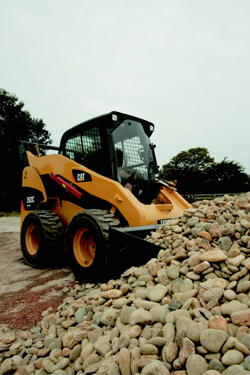
Despite the variety of pros for compact wheel loaders, these machines are still a relatively newer player in the North American market. Skid steers have reigned supreme in the U.S. compact equipment industry since the 1960s and today includes large product lines from manufacturing magnates such as Caterpillar, Bobcat, Case, New Holland, JCB, Volvo, Komatsu, Mustang and Gehl. In comparison, today’s compact wheel loader market is definitely growing, but still at a much smaller percentage of units sold — not to mention the model lines are much smaller from companies like Terex, Kubota, Mustang, Yanmar, Komatsu, Gehl, Volvo and Caterpillar.
As with any machine purchase decision, a multitude of factors can come into play. But most experts — and users — likely will agree with Caterpillar’s Lynnes who notes that the best machine “is always the one that meets the requirements of the job.”


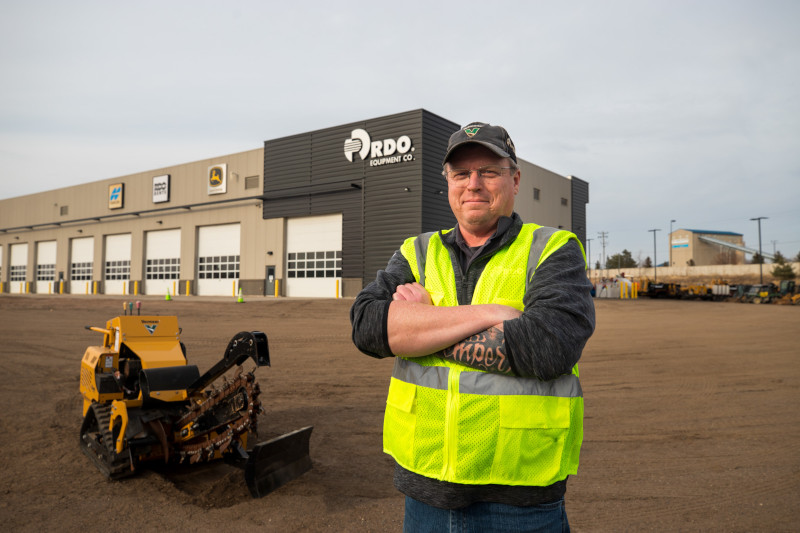

Comments are closed here.